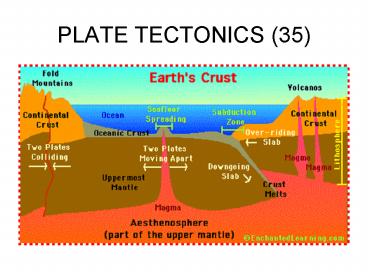PLATE TECTONICS (35) - PowerPoint PPT Presentation
1 / 10
Title:
PLATE TECTONICS (35)
Description:
PLATE TECTONICS (35) Plate Movement Theory of plate tectonics, Earth s crust and part of the upper mantle are broken into sections. These sections, called plates ... – PowerPoint PPT presentation
Number of Views:175
Avg rating:3.0/5.0
Title: PLATE TECTONICS (35)
1
PLATE TECTONICS (35)
2
Plate Movement
- Theory of plate tectonics, Earths crust and part
of the upper mantle are broken into sections. - These sections, called plates, move on a
plasticlike layer of the mantle
3
Lithosphere
- Continental Crust part of upper layer of
mantle Lithosphere - Plasticlike layer below the lithosphere is called
the asthenosphere. - Plates of the lithosphere float and move around
on the asthenosphere.
4
- Divergent Plate Boundary plates move apart. Ex.
Mid-Atlantic Ridge - Convergent Plate Boundary two plates colliding.
Ex. Himalyan Mountains - Transform Plate Boundary two plates slide passed
one another in opposite direction. Ex. San
Andreas Fault
5
- Divergent Plate Boundary- creates new crust
- Convergent Plate Boundary- subducts old, dense
oceanic crust or creates mountains - Oceanic Continental Plate- Oceanic goes
underneath continental. - Continental- Continental- push together and form
mountains.
Subduction Zone- area where an oceanic plate
subducts, or goes down, into the mantle
6
- Subduction zone creates a deep-sea trench where
one plate bends and sinks beneath the other. - New magma is forced upward along these plate
boundaries, forming volcanoes.
7
Transform Boundary
- One plate slips past another suddenly,
earthquakes occur - San Andreas Fault is an example of Transform
Plate Boundary.
8
Causes of Plate Tectonics
- The cycle of heating, rising, cooling, and
sinking is called a convection current - Such convection currents (see arrows) are the
driving force of plate tectonics.
9
Rift Valleys
- Rift valleys and mid-ocean ridges can form where
Earths crust separates - Examples of rift valleys are the Great Rift
Valley in Africa, and the valleys that occur in
the middle of mid-ocean ridges.
10
http//www.youtube.com/watch?vmB2pzhWUaiU































